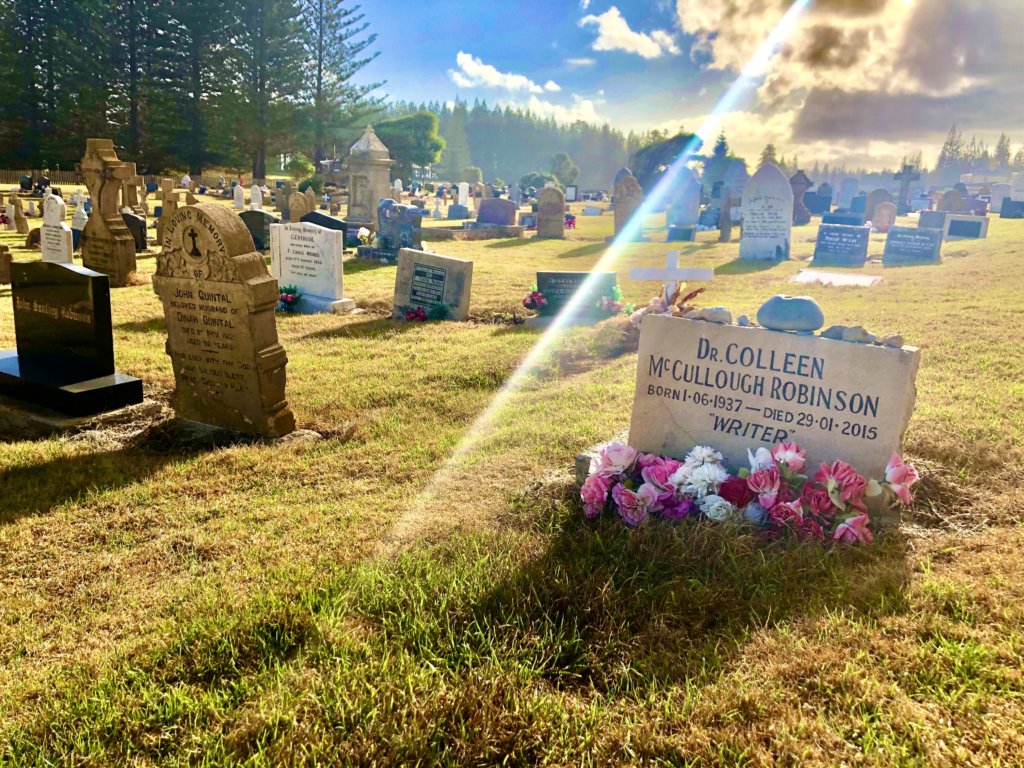Written by Sally Colin-James, the emerging writer winner of the inaugural Colleen McCullough Residency Award

There’s something about the light on Norfolk Island. A brightness, a clarity. An ever-present magic-hour that begs the attention of a lens. And, as I sit beside Dr Colleen McCullough’s headstone, I am reminded of the words of another McCullough, American writer, David Gaub McCullough, who said, ‘Writing is thinking. To write well is to think clearly. That’s why it is so hard.’
As I reflect on these words later, while wandering the aisles of her personal library within her Norfolk Island ‘Out Yenna’ estate, I realise that this ability to ‘think clearly’ was the marvel of our Australian McCullough, Colleen. That there could have been no generation-sweeping ‘Thorn Birds’ or triumphantly-researched ‘Masters of Rome’ series – seven books with a total of around 7,000 pages – without the skill of clear-thinking to manage each book’s vast terrains. And that this clarity underscored her intellect, her wit and her acute sense of perception.
I have come to Norfolk Island as an awardee of the Historical Novel Society of Australasia’s (HNSA) inaugural Colleen McCullough Residency Award. The Residency, conceived to support one emerging writer (me) and one established writer (author Chris Bell) of historical fiction, is the brainchild of the HNSA, and sponsored by Baunti Escapes and Burnt Pine Travel. And, like all life-changing experiences, it is set to challenge both myself and my work with my day-one graveside revelation: no amount of writing – even good writing – can hide unclear thinking.

Colleen’s writing success is renowned. But now, as I sit here in the cemetery beside a small headstone engraved with one of Australian cultural history’s biggest names, I wonder what it felt like at the time to be a best-selling, if not ground-breaking, female author with Colleen’s clout. But more so, I wonder if all that ‘clear thinking’ meant she had no choice but to write. That it offered a way to ease the unbearable brightness of seeing. That inevitable sharp definition. Both the gift and burden for those with a clear-thinking mind.
I snap a photo and check to see how clearly I’ve captured what I see here by her graveside. In the photo, a rainbow shaft of light streams from the clouds and strikes the writer’s grave. I study the image. Working through theories of technical lens flare or mystical intervention. It doesn’t matter the answer, I decide. What matters is that the photo I’ve taken and the moments leading up to it have begun to answer my niggling worry as to why the current draft of my historical fiction, ‘The Recipe for White’, is not quite working. No amount of word-churning is going to fix it. What I have to do is get clear.
It sounds simple enough. But how, exactly, how does a writer ‘get clear’?
I recall the words said to me by another fine Australian writer, Melissa Lucashenko: you must be succinct before you can be beautiful.
I write a list of my characters and ask them, addressing them by name: What is the point of you? What value do you bring? How well do you earn your place? I map out the parallel narrative arcs and actively seek out boring bits, the decorative bits, the digressions that might (for all their presumed importance) waste a reader’s time. I write and re-write my logline until that single sentence is an elegy to brevity.
During the residency, I write daily and abundantly. At the end of each day, Chris and I meet and discuss and dissect and flesh out. But all the time I am wondering when I will face what seems unbearable. To summon due confidence and step back from the manuscript in order to take a better look at, to really see, what is going on within it. I imagine Colleen, not famous for being subtle, drawing back hard on a cigarette and, while exhaling, telling me to show some guts and get on with the job.
To ride the wake of Colleen’s legacy means to witness a writing life in full motion. And to cope with the comparisons-to-self that arise. She was known to ‘pound out’ 15,000-word chunks at a time and evict party guests from the house late in the evening in order to write through the night. As I wander around her guest house and home, I am struck by her curatorial eye. What some may view as ostentatious, to me, reveals a woman with a keen eye for pieces that, like her epic and globally successful novels, endure.
A 1960’s Murano ceiling light composed of a myriad perfect pastel pink and green glass flowers, Paradiso marble coffee tables, ornate azure-floral Broadhurst wallpaper and matching curtains, lemon-yellow velveteen armchairs, a Baccarat crystal ball, an ancient Kokopelli statue (a Native American figure of fertility and prosperity rendered as a wandering minstrel with a bag full of rainbows), French antique Jester chairs and Charles Hollis Jones Lucite-armed chairs from America, cut crystal ashtrays and faceted crystal mirrors, paintings by Gleeson, Dresden and Nolan, hardcover art books from Kandinsky to Klee. And then, and then! There are the Boulder opal encrusted tables that I lean close to, not wanting to touch them or mark them, peering at the set gems as if to divine something more of the Colleen that chose these. Of all the glorious objects in this home, I am intrigued by what story might lie behind the opal tables. I’ve been to Australia’s opal fields. I know the graft, the grit, the patience and sheer luck it takes to bring this kind of opal up from the ground. I move on with reluctance to take in as much as I can of her home. There seems too little time, too many extraordinary objects to absorb.
In her library her methodical and thorough approach to research is apparent. As an avid researcher, I can feel the time she has spent with these books. There are hundreds. The layering of knowledge here from the Harlequin romances (six jam-packed shelves used for what, I was told, Colleen felt were excellent location descriptions), to Cambridge History books (every period), Folio Society leather-bound books, books on ‘Cat Haikus’ and ‘Bad Popes’ and ‘When God was a Woman’ (note to self: find this book and purchase). All of it telling the story of a woman predisposed to intensive fact-finding missions. A skill that the historical fiction writer must master to satisfy the reader’s demand for authenticity. But not at the expense of story. As Colleen cautioned on the pitfalls of research: you have to know when enough is enough.
I realise that in my current draft I have more than enough. But not enough to be clear. What contradiction! At this, like Colleen was famous for, I curse. Not under my breath.
Her library feels supportive, grounding, giving the sense of a writer whose process was structured and yet expansive. And like every element of her home it feels curated, decisive. From the Australia-shaped fly swat, to the 24 carat gold-plated chandeliers that she herself designed. Every last item my gaze falls upon in her home provokes an imagined story. More than fitting, of course, for a queen of story-telling.
When I arrive back in Brisbane, I walk with my husband from our hotel along the Brisbane river. I am talking, he is listening. And I try to explain the magnitude of the sights and my insights from the day-one graveyard rainbow to the Boulder opal tables. We pass a small weekend market in the botanical gardens. A stall brimming with opals catches my eye. I usher my husband over to it and pick up one half-polished gem. ‘These are exactly what Colleen has encrusted in two big tables!’ I tell my husband. The owner of the stall is busy serving somebody else but he pricks up his ears.
‘Did I hear you mention a Boulder opal encrusted table?’ asks John Doyle from Boulder Opal Mines Australia, the stall run by him and his partner, Leanne Smedley.
‘I saw them on Norfolk,’ I reply. ‘I wish I knew more.’
‘Well, I tell you what I know,’ says John Doyle. ‘A bloke called Des Burton, a chemist from Quilpie, was a keen opal miner back in the seventies and did well with his dozer. He was known to have made only a few of the tables. We know where a few of them ended up. But the location of others remains a bit of a mystery!’
Were you laughing, dear Colleen, to see me slack-jawed before that market stall, finding out, as I had yearned to, ‘the story’ behind those tables I’d studied inside your home? Did you see me, for a single imperceptible blink, shrink back from this bright moment of coincidence? The type of moment an author might view with suspicion. The dreaded deus ex machina planted to wrap up a plot?
And yet here I am inside such a story.
I smile to myself. Maybe this happy ending is one to simply enjoy.
Perhaps I shy away from the kind of clear thinking good writing demands. The kind of thinking that may, at first, seem brutal. Not only ‘killing your darlings’ but tearing from the pages those moments we hoped might be tender or insightful or prove something of ourselves to the world. But what if I could, in every moment, set my sights on – first – being clear. To bear, without looking away, the primary judgment an author has towards her work, thinking it not good enough for being exactly what it must. To see what must be seen without the blinkers of fear or insecurity. And to write from this brightness. As did Colleen McCullough.
I would like to extend my immense gratitude for the warm-hearted support and tireless efficiency of Elisabeth Storrs and Diane Murray from the Historical Novel Society Australasia (HNSA); the generous folk at Baunti Escapes, Les Quintal, Sue-Ellen Quintal, Kerry Christian and Debbie Randall; and from Burnt Pine Travel, Bart Murray and Juliette Grant. Winning The Colleen McCullough Residency Award has been a highlight of my writing life and I encourage all writers of historical fiction to get to work and get clear and put forward their work.




